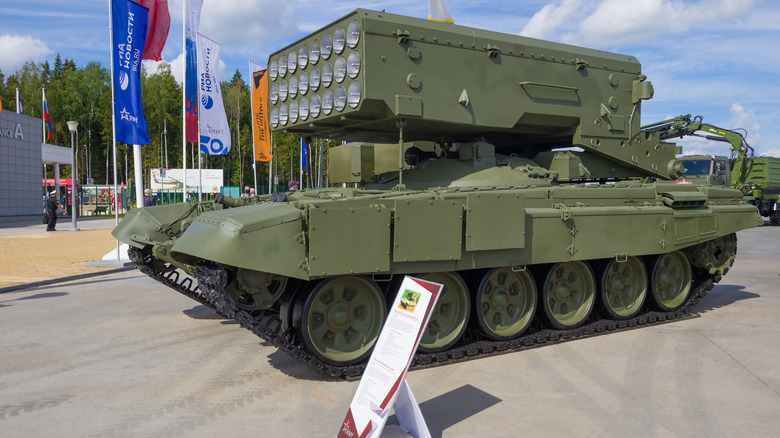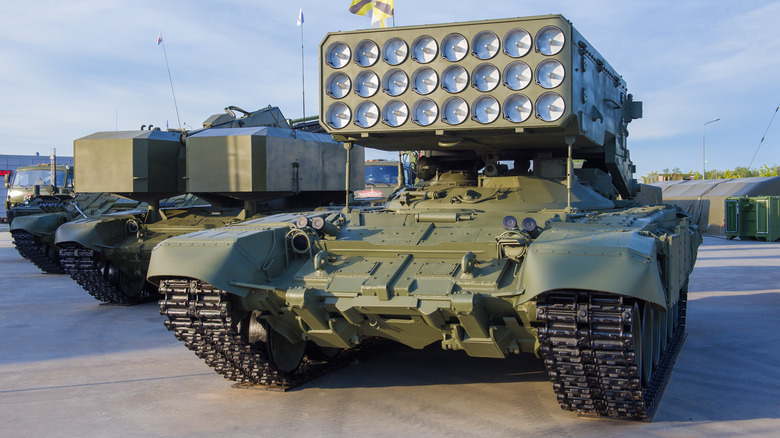Russia's TOS-1A Buratino: A Closer Look At Its Staggering Firepower
Typically, when we talk about armored fighting vehicles, they've either been decommissioned for years or, at the very least, aren't being actively used on a battlefield, but that's not the case with Russia's TOS-1A Buratino.
Russia invaded Ukraine on February 24, 2022, and the United Nations estimates that at least 10,000 civilians have been killed (560 of which were children) and more than 18,500 more have been injured. We know that Russia has been using its TOS-1A Heavy Flamethrower launchers in the region since at least March of 2022 (much like the SU-34 jet fighter), where it has been responsible for killing hundreds, if not thousands, due to its staggering firepower potential.
The TOS-1A is an upgraded version of the TOS-1, which was initially developed in the early 1980s as a testbed vehicle because it was never built in significant numbers, nor was it exported and used by other armies, unlike the 1A, which forces in Armenia, Azerbaijan, Iraq, and Kazakhstan have used.
It fires at least two types of 220 mm rockets (incendiary and thermobaric) from a BM-1 launcher unit equipped with three rows of eight tubes (24 total) attached to the chassis of one of Russia's main battle tanks (the T-72A, T-72B3, or the T-90S). The incendiary rockets are 10.8 feet long and weigh 381.4 pounds, while the thermobaric rockets are 12.1 feet long and weigh 478.4 pounds, but neither are "smart," i.e., laser-guided.
Nothing whimsical about this machine of death
These rockets, especially the thermobaric ones, are designed to cause destruction and chaos over a wide range, with a full salvo covering an area between 656 and 1,312 feet. The TOS-1A is used as direct fire support to clear buildings, bunkers, and other fortifications ahead of infantry units and main battle tanks.
When the TOS-1A fires, it usually launches a single rocket or a pair of them within half a second. A full salvo manually launched takes 12 seconds, but only half that time when launching the entire salvo automatically. The rockets have a maximum range of approximately 3.5 miles and a minimum of 1,312 ft.
It has earned a few nicknames, including Solntsepek (meaning "blazing sun" or "scorching sunlight"). The other is Buratino, named after the character in Aleksey Nikolayevich Tolstoy's 1936 novel, "The Golden Key, or the Adventures of Buratino," which is based on Italian Carlo Collodi's 1883 book, "The Adventures of Pinocchio."
Despite the whimsical nickname, this weapon is anything but. First, the word "flamethrower" is misleading. Although a stream of fire is deadly, what the TOS is capable of is infinitely more deadly. Compared to an ordinary condensed munition, the TOS uses the oxygen in the air to increase its blast's longevity and explosive force.
The blast wave from a thermobaric explosive is created by igniting powdered aluminum or some other material that will burn at high temperatures.
A thermo-barbaric hellscape
The ensuing fireball rapidly expands, burning up all the oxygen in the air, then, as it cools and shrinks, sucks whatever air is left in the area back into itself (almost like a black hole), creating a vacuum effect. Thermobaric explosives are often called "vacuum bombs" because of this particular effect.
The U.S. Army Training and Doctrine Command's (TRADOC) unclassified World Equipment Guide (WEG) says the vacuum surges created by these thermobaric explosives can be as much as 427 lbs per square inch, which in turn causes soft objects like "airplane skin, radar surface, [and] human lung tissue" to rip apart literally.
Hiding behind walls and other objects inside the blast doesn't help and actually makes the explosion worse because it creates "multiple pressure waves" that increase those tearing effects. If that wasn't bad enough, temperatures created by the blast reach anywhere between 4,532 – 5,432 degrees Fahrenheit or about half that of the surface of the Sun.
People may wonder about the legality of using such a weapon. The Center for Arms Control says a legal argument may exist under the United Nations Convention on Certain Conventional Weapons. Unfortunately, their use is — and here is the crucial turn of phrase — not explicitly banned. The United States has similar thermobaric explosives in its arsenal.

